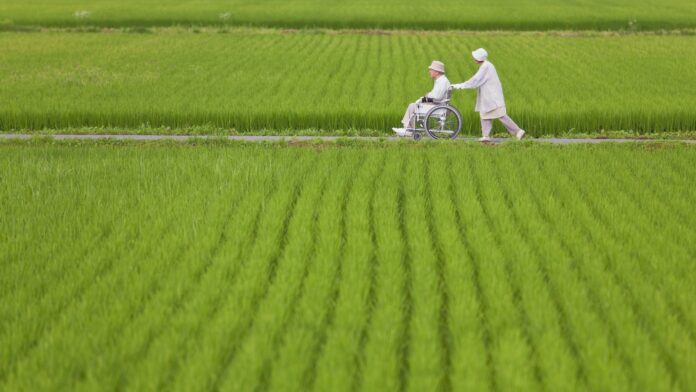Just about every developed country is aging and urbanizing, though Japan is doing so the fastest. Its solutions to combating this decline may be significant for the rest of the world. The reasons that Japan’s rural population is shrinking and aging mirror those in the United States and other developed countries. Jobs are increasingly clustered in cities, and the jobs that remain in the countryside require fewer workers than they did half a century ago. In 1950, 53 percent of Japan’s population lived in urban regions; by 2014, 93 percent did. (In the U.S., by contrast, 81 percent of the population lives in urban regions.) Unlike the United States, which has colleges and universities located across the country, Japan has few major learning centers located outside major cities, Mock said. That means as young people increasingly pursue college educations, they leave for the cities, and often don’t return.
In some rural regions, nature is reclaiming the land. Families are tearing down unused homes, turning the land back into fields. Bear attacks near settlements in Japan’s north are increasing as humans stop pruning back trees. Wild boars have been ravaging farmland. In some places, only graveyards will be left to mark the land where people once lived. Japanese towns are wrestling with dilemmas like how to run their governments with fewer tax dollars, and how to provide services for an increasingly needy population with fewer workers. Right now, the decline of these places is happening fast, within a generation or two. If it can be a more gradual process, perhaps then basic social services can at least survive for long enough to provide for the remaining residents.
One obvious solution to reversing, or at least slowing, rural Japan’s decline would be to open up the country to immigration. But Japan is a country whose national identity is, in some ways, based upon racial homogeneity. Proposals to significantly increase immigration have gone nowhere, and polls consistently find that two-thirds of Japanese are against large-scale immigration. And it’s unlikely that immigrants, even if they were allowed in, would move to rural areas where there are few jobs even for the people who want to stay.
Some towns are trying to simply adapt to the new reality. Yubari, which lost 90 percent of its population between 1960 and 2014, declared bankruptcy in 2007. Since then, it has drastically cut back on services such as public buses and snow removal, merged schools, laid off government employees, and cut funds for public parks. It relocated residents from the outskirts of town to apartments close to the city center. In some places, adapting has meant that elderly people are working for longer, or themselves taking on roles as caregivers for people who are even older. In Tochikubo, for instance, people who might have wanted to retire at 65 are still tilling the fields at 75. The average age of active farmers in Japan is 66. Seventy-year-olds like Fueki and his wife Kura care for 80-year-olds like their neighbor, Ayako Kuwabara. “In aging societies, our whole understanding of what it means to be elderly has to be shifted upwards and adjusted,” Richard Jackson, president of the Global Aging Institute, told me. “Sixty is the new 40. The question is, will 80 be the new 60?”
Kensaku Fueki and his wife Kura aren’t worried about their own aging. They can still drive, and have no difficulties going about their daily lives. They’re most concerned about the disappearance of a way of life—that no young people will come to the village and learn how to farm rice without machines or how to weave cloth or make sake.
Analysis
This article is a fascinating look into how Japan is dealing with its rapidly aging population. It discusses some of the struggles with caring for an aging population when nearly all of the young people are leaving the rural villages where their parents live in favor of education and careers in bigger cities. This includes things like a lack of nurses and caregivers, people to farm and harvest food, and even a decrease in funds for public services like buses and public parks. One of the main struggles in these villages it seems is a lack of people to do important jobs to maintain the current population, which means that a lot of the “younger” people (people who are at retirement age themselves!) have to do these jobs to care for those who are older than them. Another notable aspect is concern over the disappearance of the way of life in these rural Japanese villages. Traditional skills are not being passed down and utilized if there is no younger generation in the villages to pass it down to. From a designer standpoint, I think there is a lot of really interesting material here to base a project off of.




